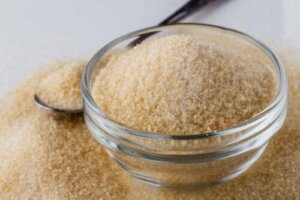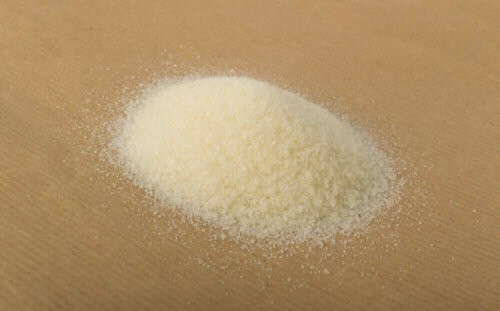Eleven Health Benefits of Gelatin in Your Diet


Reviewed and approved by Doctor Carlos Fabián Avila
There are many health benefits to adding gelatin, a semisolid and colorless substance, to your diet. This substance derives from collagen after boiling animal connective tissue. In general, people use it to thicken jellies, sauces, gummies, and cakes, among others.
However, other than its culinary uses, it can also prevent and treat a wide variety of illnesses. Although it isn’t a medicinal or superfood, its nutritional content has been associated with the prevention and treatment of some health problems. Do you know what its eleven health benefits are?
Nutritional properties and health benefits of gelatin
According to information in the Encyclopedia of Food and Health, gelatin is an insoluble protein obtained by the hydrolysis of collagen, a basic structure found in the skin, tendons, bones, and connective tissues of animals. It stands out as a product with wide applications in the cosmetic, pharmaceutical, photographic, and food industries.
According to Wikipedia, clear gelatin is made up of 98% to 99% protein and 2% minerals. However, it’s an incomplete protein as it doesn’t contain all the essential amino acids. Its most abundant amino acids include:
- Glycine 27%
- Proline 16%
- Valine 14%
- Hydroxyproline 14%
- Glutamic acid 11%
However, this composition of amino acids may vary depending on the type of animal tissue used in its preparation. However, in general, gelatin is the food source with the most glycine, an amino acid that’s very important for your health.
As for other nutrients, which are minimal, it can provide vitamins and minerals such as sodium, calcium, phosphorus, and folic acid, according to data from SELF Nutrition Data.
Eleven health benefits of gelatin
Before getting to know the health benefits of clear gelatin, it’s important to make some clarifications. First of all, denying what some people claim, it isn’t a “healing” or “super” food against diseases. While it has shown beneficial effects, there’s no evidence it can be a cure for health problems.
Another thing to keep in mind is that it isn’t a substitute for medical treatment. In some cases, it could be considered an adjuvant to improve the symptoms of some diseases. However, it shouldn’t be a first-line treatment. In case of doubt, it’s best to consult your doctor.
1. It helps manage blood sugar
Glycine is one of the amino acids in gelatin. According to research published in the Journal of Endocrinological Investigation, this amino acid may help patients with type 2 diabetes control their condition.
Specifically, it helps reduce high blood sugar levels and prevents complications associated with inflammation.

Read some Tips for Detoxing Your Body
2. It improves digestion
In addition, gelatin is hydrophilic. In other words, it attracts and absorbs liquid, even when it’s already cooked. This characteristic allows it to be a great ally for the digestive system. This is because it retains stomach juices and facilitates food digestion.
Absorption of gelatin also improves movement within the intestines. Plus, it aids the expulsion of waste that tends to get stuck in the colon. Thanks to its provisions of glycine, restoration of the gastric mucous membrane are possible. Hence, it optimizes the absorption of nutrients and prevents the development of digestive diseases.
3. Gelatin improves bone and joint health
In addition, its high concentration of essential amino acids also makes gelatin a good supplement for maintaining bone and cartilage health.
Although evidence is limited, its anti-inflammatory properties fight off aches within these areas. At the same time, as concluded by a study published in Seminars in Arthritis and Rheumatism, they decrease your risk of illnesses such as arthritis and osteoarthritis.
4. One of the health benefits of gelatin is it’s a source of proteins
After all, gelatin is composed of more than 90% of proteins with high biological value. First of all, they increase energy levels. Plus, they also contribute to building more muscle mass and improving endurance.
Gelatin is very good for athletes and pregnant women. After all, our bodies easily absorb and take advantage of its amino acids. This makes it easier for the cells to take advantage of them.

5. It strengthens your nails and hair
Nails and hair can also benefit from the amino acids contained in the gelatin. These properties can be exploited both by consumption and external application. In fact, many hair products contain it among their ingredients.
6. It improves skin health
Collagen is one of the substances most used in the manufacture of lotions and cosmetic skincare treatments. Gelatin has a cooked collagen base. Thus, it provides the necessary amino acids to keep the skin looking young and healthy.
Its consumption and topical use minimize the negative effects of the sun and other toxins. Furthermore, as detailed in a study published in the Journal of the Science of Food and Agriculture, they prevent the appearance of premature wrinkles.
7. It helps relieve stress and anxiety
Glycine also works as a natural soother capable of stopping excessive production of norepinephrine. This is a hormone related to states of anxiety and panic. Its absorption balances the activity of the nervous system. Plus, it slows down the production of stress-related hormones.

8. It repairs the intestinal wall
The components of gelatin are useful for reducing the intestines’ permeability. This is made possible by repairing the intestinal wall that tends to get irritated by food allergies and some diseases.
Consequently, this quality allows improvement of the nutrient absorption process derived from food. Therefore, it keeps the body in a perfect state.
9. It helps you sleep well
Patients suffering from insomnia or other sleep disorders can stand up to these problems by just adding a portion of gelatin to their diet.
The amino acids and essential minerals increase melatonin production. According to a study published in Sleep and Biological Rhythms, this is a hormone that induces a good dose of sleep.
10. It helps you lose weight
Due to its low caloric content and high protein levels, gelatin is a good complement for trying to lose weight.
While there’s no evidence demonstrating the relationship between gelatin consumption and weight loss, some studies reveal that optimal protein intake plays a key role in body weight control.
These substances slow down the insatiable urge of calorie intake. Plus, they increase energy expenditure during activities of physical demand.

Check this out: 9 Tips to Boost a Slow Metabolism
11. Gelatin speeds up the healing process
A recent study published in the Journal of Biomaterials Applications found that the anti-inflammatory and healing properties of gelatin are useful in speeding up the healing of internal and external injuries. That’s why it’s great for the recuperation of superficial cutaneous lesions and disorders such as ulcers.
The health benefits of gelatin as a complement
Studies have found positive effects of clear gelatin as a food supplement. However, the findings are insufficient to consider it a remedy. Therefore, it’s advisable to consume it as part of a healthy, balanced diet. In case of health problems, it’s best to consult a doctor.
All cited sources were thoroughly reviewed by our team to ensure their quality, reliability, currency, and validity. The bibliography of this article was considered reliable and of academic or scientific accuracy.
- Benjakul, S. & Kittiphattanabawon, P. (2019). Gelatin. Encyclopedia of Food Chemistry. Disponible en: https://www.sciencedirect.com/science/article/pii/B9780081005965215886?via%3Dihub
- Bettadapur, A., Suh, G. C., Geisse, N. A., Wang, E. R., Hua, C., Huber, H. A., Viscio, A., Kim, J., Strickland, J. & McCain, M. L. (2016). Prolonged culture of aligned skeletal myotubes on micromolded gelatin hydrogels. Scientific reports, 6(1), 1-14. Disponible en: https://www.nature.com/articles/srep28855
- Cruz, M., Maldonado-Bernal, C., Mondragon-Gonzalez, R., Sanchez-Barrera, R., Wacher, N. H., Carvajal-Sandoval, G., & Kumate, J. (2008). Glycine treatment decreases proinflammatory cytokines and increases interferon-γ in patients with Type 2 diabetes. Journal of endocrinological investigation, 31(8), 694-699. Disponible en: https://link.springer.com/article/10.1007/bf03346417
- Frasca, G., Cardile, V., Puglia, C., Bonina, C., & Bonina, F. (2012). Gelatin tannate reduces the proinflammatory effects of lipopolysaccharide in human intestinal epithelial cells. Clinical and experimental gastroenterology, 5, 61-67. Disponible en: https://www.ncbi.nlm.nih.gov/pmc/articles/PMC3358810/
- Gómez-Guillén, M. C., Giménez, B., López-Caballero, M. A., & Montero, M. P. (2011). Functional and bioactive properties of collagen and gelatin from alternative sources: A review. Food hydrocolloids, 25(8), 1813-1827. Disponible en: https://www.sciencedirect.com/science/article/pii/S0268005X11000427?via%3Dihub
- Hanani, Z. A. N. (2015). Gelatin. Encyclopedia of Food and Health. Disponible en: https://www.sciencedirect.com/science/article/pii/B9780123849472003470?via%3Dihub
- Inoue, N., Sugihara, F., & Wang, X. (2016). Ingestion of bioactive collagen hydrolysates enhance facial skin moisture and elasticity and reduce facial ageing signs in a randomised double‐blind placebo‐controlled clinical study. Journal of the Science of Food and Agriculture, 96(12), 4077-4081. Disponible en: https://onlinelibrary.wiley.com/doi/10.1002/jsfa.7606
- Jang, H. J., Kim, Y. M., Yoo, B. Y., & Seo, Y. K. (2018). Wound-healing effects of human dermal components with gelatin dressing. Journal of biomaterials applications, 32(6), 716-724. Disponible en: https://pubmed.ncbi.nlm.nih.gov/29130393/
- Jéquier, E., & Tappy, L. (1999). Regulation of body weight in humans. Physiological reviews, 79(2), 451-480. Disponible en: https://journals.physiology.org/doi/full/10.1152/physrev.1999.79.2.451
- Johnson, D., Blandina, P., & Goldfarb, J. (1994). Glycine inhibition of glutamate evoked-release of norepinephrine in the hypothalamus is strychnine-insensitive. Brain research, 650(1), 70-74. Disponible en: https://pubmed.ncbi.nlm.nih.gov/7953679/
- Liu, D., Nikoo, M., Boran, G., Zhou, P., & Regenstein, J. M. (2015). Collagen and gelatin. Annual review of food science and technology, 6, 527-557. Disponible en: https://pubmed.ncbi.nlm.nih.gov/25884286/
- Moskowitz, R. W. (2000). Role of collagen hydrolysate in bone and joint disease. Seminars in Arthritis and Rheumatism, 30(2), 87–99. Disponible en: https://www.sciencedirect.com/science/article/abs/pii/S0049017200568255
- Noma, T., Takasugi, S., Shioyama, M., Yamaji, T., Itou, H., Suzuki, Y., … & Sawaki, K. (2017). Effects of dietary gelatin hydrolysates on bone mineral density in magnesium-deficient rats. BMC musculoskeletal disorders, 18(1), 1-6. Disponible en: https://bmcmusculoskeletdisord.biomedcentral.com/articles/10.1186/s12891-017-1745-4
- Ozeki, M., & Tabata, Y. (2002). Promoted growth of murine hair follicles through controlled release of basic fibroblast growth factor. Tissue Engineering, 8(3), 359-366. Disponible en: https://www.liebertpub.com/doi/abs/10.1089/107632702760184637
- Rapin, J. R., & Wiernsperger, N. (2010). Possible links between intestinal permeablity and food processing: a potential therapeutic niche for glutamine. Clinics, 65(6), 635-643. Disponible en: https://www.ncbi.nlm.nih.gov/pmc/articles/PMC2898551/
- Scaldaferri, F., Lopetuso, L. R., Petito, V., Cufino, V., Bilotta, M., Arena, V. & Gasbarrini, A. (2014). Gelatin tannate ameliorates acute colitis in mice by reinforcing mucus layer and modulating gut microbiota composition: emerging role for ‘gut barrier protectors’ in IBD?. United European Gastroenterology Journal, 2(2), 113-122. Disponible en: https://www.ncbi.nlm.nih.gov/pmc/articles/PMC4040816/
- Yamadera, W., Inagawa, K., Chiba, S., Bannai, M., Takahashi, M. & Nakayama, K. (2007). Glycine ingestion improves subjective sleep quality in human volunteers, correlating with polysomnographic changes. Sleep and Biological Rhythms, 5(2), 126-131. Disponible en: https://onlinelibrary.wiley.com/doi/full/10.1111/j.1479-8425.2007.00262.x
- Westerterp-Plantenga, M. S., & Lejeune, M. P. (2005). Protein intake and body-weight regulation. Appetite, 45(2), 187-190. Disponible en: https://pubmed.ncbi.nlm.nih.gov/15950318/
This text is provided for informational purposes only and does not replace consultation with a professional. If in doubt, consult your specialist.








